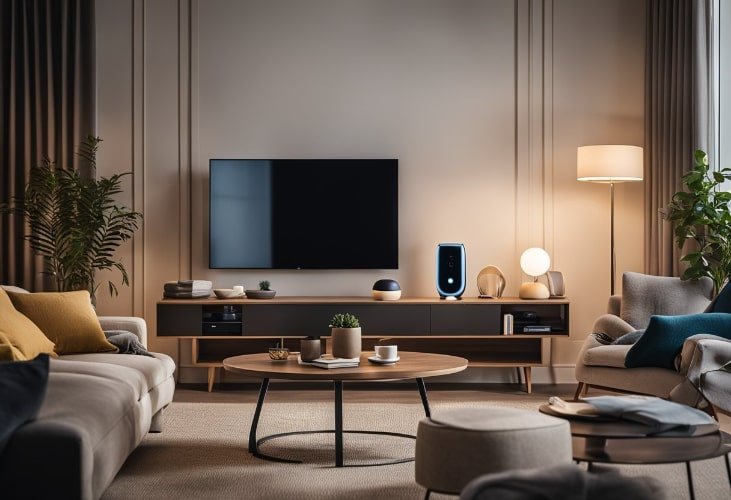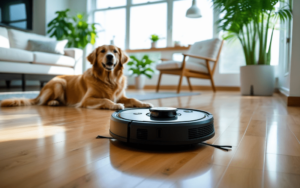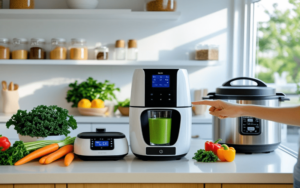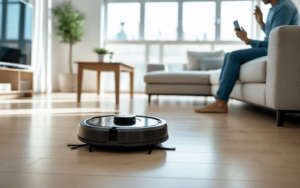Creating a smart home doesn’t have to be an expensive endeavor.
You can easily set up a smart home on a budget by choosing cost-effective devices that integrate seamlessly with your chosen smart assistant.
Many affordable options are available, allowing anyone to control lighting, climate, and security with simple voice commands or app controls.
Key components of a budget-friendly smart home include smart bulbs, plugs, and switches.
Smart bulbs, for instance, can significantly enhance convenience and energy efficiency.
Devices like smart speakers and automation hubs also centralize management, offering a comprehensive solution for any tech-savvy homeowner.
To ensure the best experience, it’s vital to start with high-speed internet, which serves as the backbone of any smart home system.
With robust internet, you can maintain smooth operation and connectivity for all devices, maximizing the benefits of your smart home setup.
Please note that this article contains affiliate links. As an Amazon Associate, we earn from qualifying purchases at no extra cost to you.
Understanding Smart Home Basics

A smart home integrates technology to enhance convenience, security, and energy efficiency. It leverages connected devices that communicate through various protocols to automate routine tasks.
Defining a Smart Home
A smart home uses devices connected through the internet to enable remote management.
Devices include lights, thermostats, security cameras, and appliances, often controlled via a smartphone app.
These components communicate using protocols like Zigbee, Z-Wave, or Wi-Fi.
Voice assistants like Amazon Alexa or Google Assistant often serve as the command hub, allowing for hands-free operation.
Compatibility among devices is crucial to ensure seamless interaction.
Starting with basic, cost-effective devices like smart plugs can gradually build a comprehensive setup, focusing on personal needs and preferences.
Benefits of a Smart Home
Smart homes offer heightened convenience by automating mundane tasks.
Lights can turn on based on occupancy, and thermostats can adjust temperatures according to user schedules.
This automation not only saves time but also promotes energy efficiency, potentially reducing utility bills.
Security is another significant advantage.
Smart cameras and doorbells provide real-time alerts directly to the homeowner’s smartphone, enhancing peace of mind.
Environmental monitoring devices can detect issues like water leaks or smoke, offering an additional layer of safety for the home.
Choosing Budget-Friendly Smart Devices

Setting up a smart home on a budget requires selecting devices that deliver essential features without inflating costs. Key categories include smart bulbs, smart plugs, and smart hubs, each offering distinct advantages.
Smart Bulbs and Lighting Solutions
Smart bulbs are an excellent way to kickstart a smart home setup. These bulbs allow users to control lighting through apps and voice commands.
Brands like Philips Hue and Wyze offer reliable options at competitive prices.
Many budget-friendly smart bulbs include features such as adjustable brightness and color temperature settings.
This capability is perfect for creating the right ambiance at any time of day.
Using LED technology, they also consume less energy, which can lead to reduced electricity bills over time.
Installation is straightforward, as these bulbs fit into standard light sockets.
Compatibility with major smart assistants, such as Alexa and Google Assistant, is commonly available, enhancing their versatility.
We may earn a small commission if you purchase through this link. Thank you for supporting our content!
Cost-Effective Smart Plugs
Smart plugs are simple devices that turn regular appliances into smart ones. They provide an economical approach to controlling lamps, fans, and more with a smartphone.
Noteworthy examples include Kasa Smart Plug and Amazon Smart Plug.
These devices connect to a Wi-Fi network and can be scheduled to turn on and off at specific times.
This feature offers both convenience and energy savings as appliances are only on when needed.
Smart plugs are typically compact and easy to set up, requiring no special wiring.
They integrate well with smart assistants, allowing for voice command operation. This makes them a seamless part of a smart home environment.
We may earn a small commission if you purchase through this link. Thank you for supporting our content!
Affordable Smart Hubs and Controllers
Smart hubs are crucial for connecting multiple smart devices and ensuring seamless communication between them.
Affordable options like Samsung SmartThings Hub or the Wink Hub can efficiently handle several devices simultaneously.
These hubs often support popular smart home protocols, such as Zigbee and Z-Wave.
This compatibility ensures a wide range of devices can be integrated into the ecosystem.
Hubs typically offer robust app interfaces that simplify device management. This ease of use makes them ideal for users looking to unify their home automation setup.
Some models support automation routines, further enhancing the smart home experience.
Setting Up Your Smart Home System
Setting up a smart home system involves establishing a reliable Wi-Fi network, integrating devices with a central smart hub, and adjusting settings for effective automation. These steps ensure that your smart home is both functional and user-friendly.
Creating a Secure Wi-Fi Network
A secure Wi-Fi network is fundamental for any smart home system.
Start with a strong, unique password to deter unauthorized access.
It’s important to use WPA3 encryption if available, as it provides enhanced security.
For better network management, consider setting up a guest network specifically for smart devices.
Router Placement is crucial.
Position it centrally in the home, ideally elevated, to minimize dead zones.
Additionally, updating your router’s firmware regularly helps protect against vulnerabilities.
Using Wi-Fi extenders can also improve coverage in larger homes.
Firewall settings on your router should be enabled to add another layer of protection.
Consider using a Virtual Private Network (VPN) for remote access to your smart home system, which can provide additional security.
Pairing Devices with Your Smart Hub
The smart hub acts as the control center for connected devices.
Selecting a compatible hub is critical. Ensure it supports your device ecosystem, matching standards like Zigbee or Z-Wave.
Device Pairing typically starts with placing devices close to the hub during initial setup to ensure a stable connection.
Follow the manufacturer’s instructions, often requiring a dedicated app or the smart hub’s interface.
For voice control, integrate your hub with voice assistants like Amazon Alexa or Google Assistant for greater convenience.
Troubleshooting Tips include verifying that all devices are within the Wi-Fi range and checking that firmware is up to date.
If a device isn’t connecting, restarting both the hub and the device can often resolve issues.
Configuring Device Settings and Automations
Fine-tuning device settings can enhance usability and efficiency.
For instance, adjust lighting brightness and temperature preferences in smart thermostats through their respective apps.
Most devices allow customization options, which can be accessed in their settings menu.
Automation Routines involve setting up schedules or triggers to dictate device behavior.
This can automate daily routines, such as turning on lights at sunset or adjusting thermostats as needed.
Use IFTTT (If This Then That) for more complex automations involving multiple services or devices.
Testing and iterating on automation rules regularly ensures they meet your needs.
Regular updates to device software can introduce new features or improve existing functionality.
Maintaining and Expanding Your Smart Home
Proper maintenance and thoughtful expansion can enhance the functionality and longevity of a smart home. Regular updates ensure devices operate securely and efficiently, while strategic budgeting allows for continuous growth without financial strain.
Regular Updates and Security Checks
Regular updates are crucial for maintaining a secure and efficient smart home.
Manufacturers frequently release firmware updates to address security vulnerabilities and improve performance.
It is important to periodically check for these updates on each device’s app or website.
Security checks are equally vital.
Use strong, unique passwords for each device and consider enabling two-factor authentication where available to prevent unauthorized access.
If your system uses a central hub, ensure that it is always updated and protected.
Monitoring connected devices through a secure network can minimize risks.
Consider regularly reviewing device permissions and configurations to ensure they meet your security standards.
Adding New Devices on a Budget
Expanding a smart home does not have to break the bank.
Start by identifying the most needed functionalities, such as improved lighting, security enhancements, or energy efficiency.
Set a clear budget and prioritize as needed.
Consider smart home devices that offer multiple features, such as smart speakers that can also control other devices.
Look for discounts, bundle deals, or refurbished options to save money.
Compatibility with existing systems is crucial to avoid unnecessary expenses.
Utilize open-source platforms and community forums for cost-effective integration options and helpful expansion tips.
Making smart purchasing decisions can maximize the effectiveness of your smart home within financial constraints.
This article contains affiliate links, which means we may earn a commission if you purchase through our links, at no extra cost to you. As an Amazon Associate, we earn from qualifying purchases. Thank you for supporting our content!




